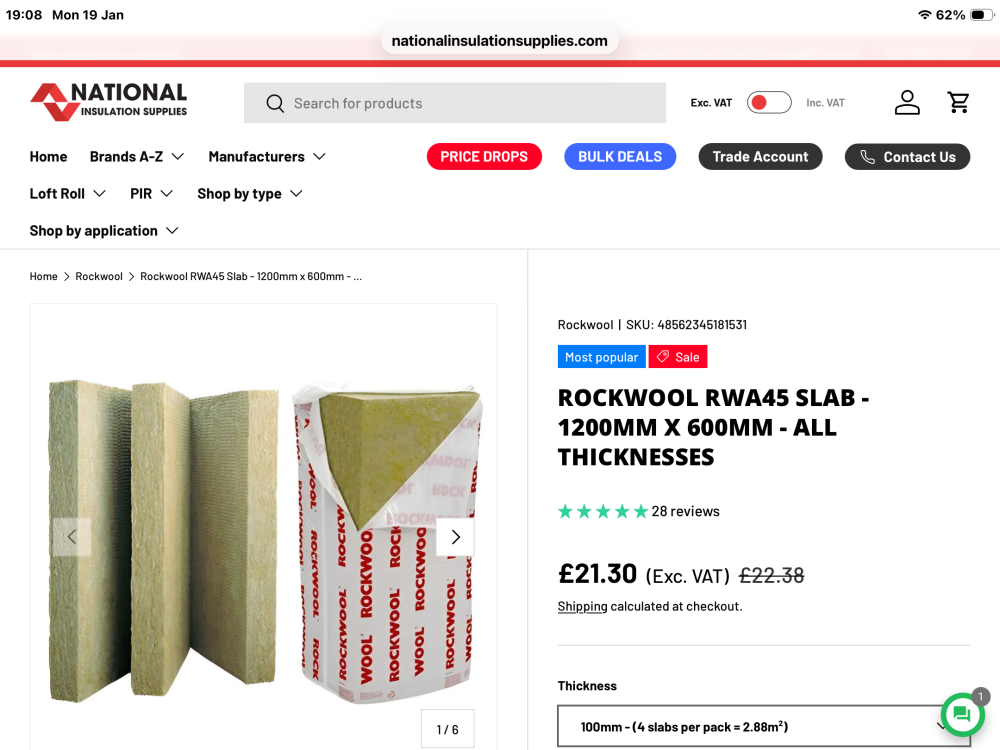-
Posts
7650 -
Joined
-
Last visited
-
Days Won
55
Everything posted by Russell griffiths
-
Just buy a box of 12 illbruck fm330 once you have used it you will never buy anything else. box quantity gets the price to below toolstation rubbish.
-

Visqueen contract design service 😮💨
Russell griffiths replied to flanagaj's topic in General Self Build & DIY Discussion
If I’m right you are having a cavity, check the details for this area in particular. -
How are you running services, you could run a service batten on top of the insulation then fix plasterboard to that.
-

Lightweight ceiling board options
Russell griffiths replied to Hammertime's topic in Plastering & Rendering
Have you looked at clay plaster that is applied at thinner thickness a mate of mine did a couple of walls in a hotel recently and I think he said it was thin like skim coat, he troweld it up for hours and it changed colour the more he worked it. -
Why 3 bathrooms in a 4 bed that your selling i would think the market would expect an en-suite to the main bed then a family bathroom on the first floor and cloakroom toilet downstairs. Saves a big chunk of cash. what sort of houses are available locally and have you been to look at a few that will be in the price range you are aiming for.
-

Lightweight ceiling board options
Russell griffiths replied to Hammertime's topic in Plastering & Rendering
Why the clay plaster ? if you had 3 chubby roofers working on your roof would you be concerned it was going to collapse? if it had plasterboard and skim before then all you are adding is the weight of the clay plaster, minus the original weight of the skim plaster. if you think that will overload your timbers then they should all be replaced now. how much do you think snow load is calculated at ? far more than a light fixture I think you need something else to worry about. -

I don't have green fingers, what to do?
Russell griffiths replied to Post and beam's topic in Landscaping, Decking & Patios
Pictures needed really -
Now that is certainly a better thing to worry about, I would start a new post about fire proofing and ceilings. as soon as you start going 3 storey everyone gets a bit fidgety.
-
Nobody will be coming and counting light bulbs, get it in.
-

Can't find a brickie (Hampshire). Any suggestions?
Russell griffiths replied to flanagaj's topic in Brick & Block
I’m not sure i would be looking in the merchants you have a few things going on here you had a post asking how to get a certain mortar colour, and this is mainly down to quality tradesmen getting the local Joe who slashes up an extension every week is not the man I would want. for a whole hose with multiple openings I would want a quality team. cheap n cheerful is not what i would want. -

Maintaining air tightness with downlighter
Russell griffiths replied to Annker's topic in Heat Insulation
In that case you will need a full depth of joist box all taped up. make them bigger than needed. -

Can't find a brickie (Hampshire). Any suggestions?
Russell griffiths replied to flanagaj's topic in Brick & Block
Show us a picture of the build, your times seam woefully low. -

Bending small aluminium sheets
Russell griffiths replied to Dunc's topic in General Self Build & DIY Discussion
2mm is far too thick to diy bend without the correct gear, either get some thinner material or just buy a pre bent piece. Most roof materials are well under 1mm the only thing I have in metal thicker than 1mm are the window cills and they are probably only 1.5mm. -
After living in Australia this is a common thing over there. a large plot of land is divided into a few dozen house plots, the local companies come in and buy and build their design house on that plot, punters then visit at the weekend and walk around all the show houses. you pick a builder you like and commission them to build on a plot you have or they will have other plots on other sites. I really hate the English way of a divided up estate all built by the same contractor in the same boring design to the same poor standard.





